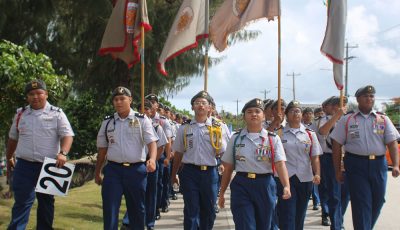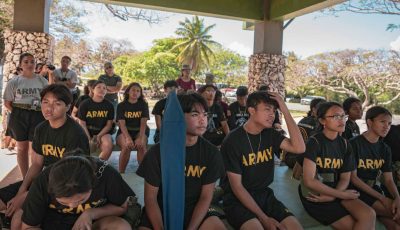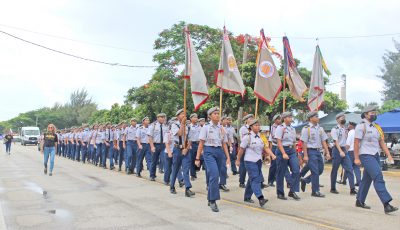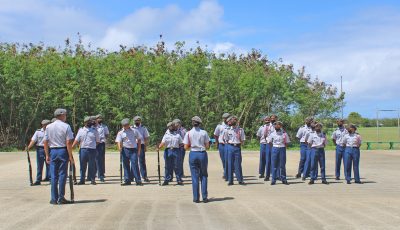CNMI JROTC tackles newly implemented JROTC Program Accreditation assessment

SSHS Briefs the 8th Brigade JROTC Evaluators on Planning, Execution, and Reflections of their Service Learning Projects. (Contributed Photo)
The focus of Army JROTC is reflected in its mission: “To motivate young people to be better citizens.” The Program of Instruction focuses on the development of better citizens by building skills in leadership, citizenship, life success, geography, and wellness, in a structured interactive environment. The Program of Instruction is designed to teach high school students the value of citizenship, leadership, service to the community, personal responsibility, and a sense of accomplishment, while instilling in them self-esteem, teamwork, and self-discipline.
The JROTC Program of Accreditation: The Formal Inspection Protocol, formerly known as the Cadet Formal Inspection, has been on hold for the past several years as the Army Cadet Command revised its federal regulations to develop a system more in line with the accreditation process used by school systems throughout the country.
The new program is titled the JROTC Program of Accreditation, or JPA. The CNMI Public School System’s JROTC Program was selected by Cadet Command to serve as a “pilot” in the newly implemented national protocol. This “pilot” assessment will implement the National JPA Program and will assist the evaluators in their assessments of how it has been formulated and corrections needed to facilitate the inspection process. Cadet Command designated 10 percent of their 1,700 programs worldwide to take part in this new process.

SSHS JROTC Staff Briefs the 8th Brigade Evaluators on the Manta Ray Battalion Continuous Improvement. (Contributed Photo)
8th Brigade officials are also assessing Guam, South Korea, and Japan schools on this visit. Other officials are looking at schools in the Western United States.
The JPA school visit is designed to assess the unit primarily in the areas of teaching and learning. This visit is composed of accreditation criteria that include cadet participation and knowledge, assessment of both the cadet and instructor portfolios’ as well as drill and ceremony execution.
Accreditation activities include: Staff Battalion Continuous Improvement Briefing (Action Plan); Service Learning Briefing; Cadet Portfolio and Interview; Unit Report; Drill; In-Ranks; Color Guard; S-1 Interview; S-2 Interview; S-3 Interview; S-4 Interview; S-5 Interview; Cadre Portfolio and Interview; and Instructor Portfolio and Interview.
Due to the outstanding performance of all of the five CNMI PSS JROTC programs, the CNMI PSS JROTC will not be assessed again for three years.
Lt. Col. Bob Gay, director of Army Instruction, said the DAI Office and all five of the CNMI’s high school programs have been preparing for the JPA Accreditation Process for the past five months. The level of work and coordination involved in this process was prodigious. Cadre Professional Development sessions, Functional assistance visits by Cadre to other than their own schools and the DAI office solidified the unity, professionalism and selfless service of the entire program. He said that he was most proud of the teamwork shown by the JROTC instructors as they worked together sharing best practices across the board. Gay also credited Guam JROTC Cadre for sharing their experiences.
Rota High School JROTC was the first program inspected and they were off to a great start. They excelled in all areas. The average score for all five of our JROTC programs was 94.75 percent.
“Two of our high school programs received the highest scores in the 8th Brigade,” Gay said.
He said the JPA is a more difficult process than the former Cadet Formal Inspection.
“Each school earned what they got. There were no easy tasks,” he added.
After Action Reviews and Reflection sessions will now be conducted at each JROTC program and the DAI office to capture the results of the inspection and implement areas requiring improvements.



























